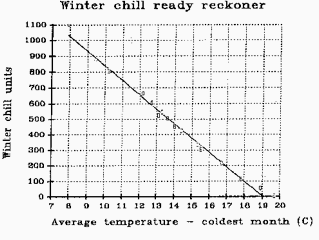Oops! I’ve just put in an order to buy a couple more of these fruit trees, there’s barely space left but I just can’t help myself. If you’re considering buying any bare root fruit or nut tree this winter, it’s worth taking a good look at the needs of the tree first. Not only is it important for a fruit tree to get sunlight, air and water, many of the trees we rely on for fruit and nuts rely on a good deep winter dormancy to produce fruit the following Summer.

Both pome fruit trees (with a core and pips like apples & pears) and stone fruits (cherries, peaches, nectarines, apricots plums etc) need cold hours to stimulate the massive phsyiological changes these trees undertake in the noble pursuit of fruit production. Pome fruit especially rely on a good long chill, and there are also berry plants which also need the cold including raspberries & blueberries. It’s amazing to think that the productivity is directly brought about by that winter chill. And this is one of those rare occasions when us cold climate dwellers get to be the envy of people living in the tropical, sub-tropical and even the warmer temperate areas. You’ll see in fruit tree suppliers’ catalogues like Woodbridge, Daleys or Diggers that different species and cultivars and their rootstocks are variously described as having Low, Medium or High Chill requirements which vary from species to species. Traditional apple varieties have a minimum chill requirement of about 1000 hours, that’s a ‘high chill’ requirement for an apple tree. Use this ready reckoner to estimate the chill hours for your area, based on the average temperature of your coldest month of the year.
Using this method, Katoomba comes in with an average 1200 chill hours whilst Springwood’s milder climate gets around 1100 chill hours.
It’s important also to consider how variable the seasonal conditions are too, particularly if you’re aiming to provide for your fruit needs from your own trees. Too few or too many chill hours can interfere with a tree’s ability to fruit, so look at the maximum and minimum chill hours as well as the average to understand the range of winter your area has historically experienced.
Our climate is changing, and that’s another factor to take into account in a long term fruit production strategy. In this visualisation of Sydney’s seasonal temperatures, you can clearly see that the lower temperatures shown in dark blue decreasing over time, indicating milder winters, with less chill hours.
 The band of blue is also narrowing as it fades meaning winter is also getting shorter. In the upper mountains its a familiar story, the snows don’t come down in big drifts like they used to. In Katoomba if the temperature rises as predicted, we’ll see an increase in temperature by 2 °C on average over the year, which will bring Katoomba chill hours down to about 1000. That will knock off very few varieties out of production. In Springwood, which is currently marginal for high chill requirement fruits, its a different story. That 2° C increase in Springwood would drop their chill hours well below into 900 , so they’ll either have to get a bit nifty with engineering cooler microclimates around their existing chill requiring trees or perhaps get more familiar with trees traditionally grown at latitudes nearer the tropics.
The band of blue is also narrowing as it fades meaning winter is also getting shorter. In the upper mountains its a familiar story, the snows don’t come down in big drifts like they used to. In Katoomba if the temperature rises as predicted, we’ll see an increase in temperature by 2 °C on average over the year, which will bring Katoomba chill hours down to about 1000. That will knock off very few varieties out of production. In Springwood, which is currently marginal for high chill requirement fruits, its a different story. That 2° C increase in Springwood would drop their chill hours well below into 900 , so they’ll either have to get a bit nifty with engineering cooler microclimates around their existing chill requiring trees or perhaps get more familiar with trees traditionally grown at latitudes nearer the tropics.
Find out more about trees, climates and resilient strategies for food production with Katoomba Street Permaculture’s permaculture design certificate course this Spring.
Words by Sue Girard & Kat Szuminska [CC-BY-SA 3.0]
Crabapple photo by Tatania12:flickr [CC BY 2.0]
Awesome Seasonal Temperature Visualisation by Hatchersan @markact
Illustration Resources graph courtesy of http://www.newcrops.uq.edu.au/acotanc/papers/campbel1
More information about growing fruit trees (especially apples)
South east Producers Association (SEPA) http://www.davewilson.com/homegrown/gardencompass/gc14_jan_07.html http://www.orangepippintrees.com/articles/fruit-tree-minimum-chill-requirement
http://hydrology1.nmsu.edu/nmcrops/Trees/apples/ http://www.aussieapples.com.au/ http://www.motherearthnews.com/blogs/blog.aspx?blogid=2147484355







